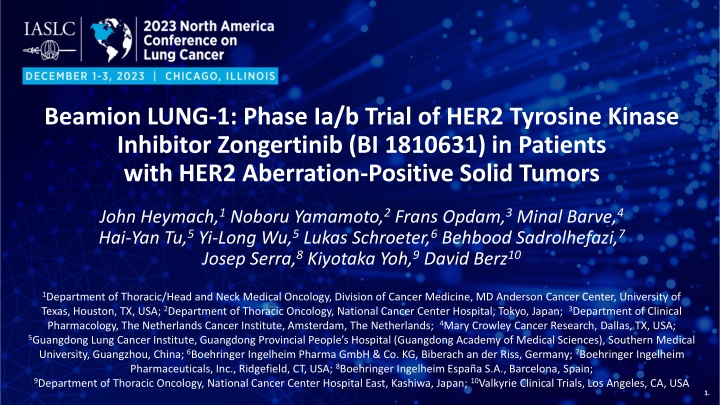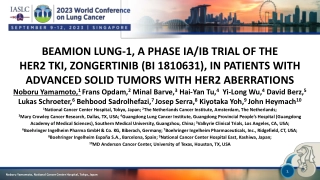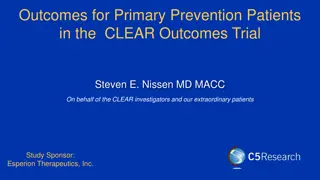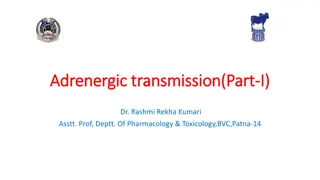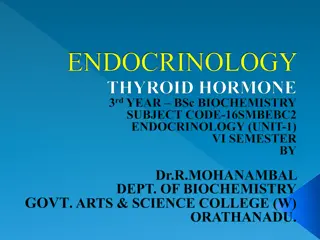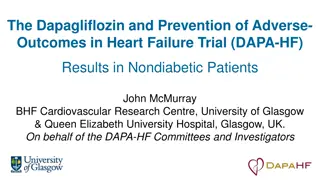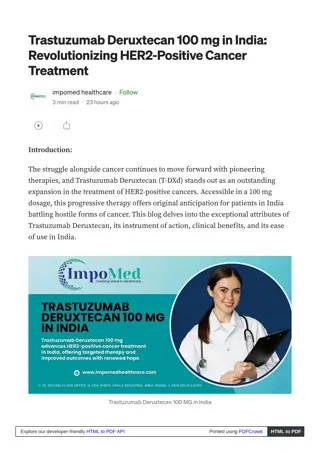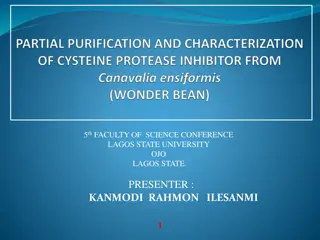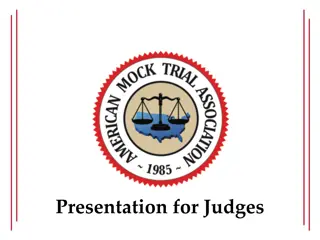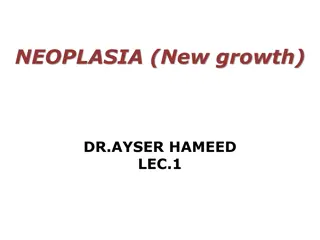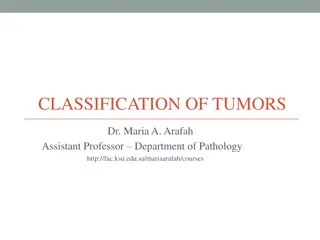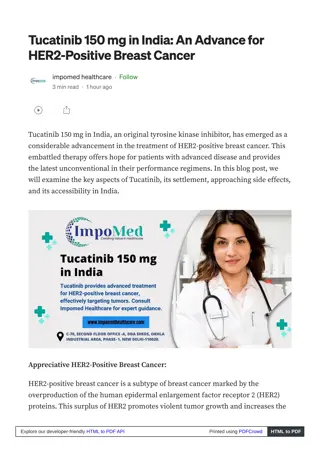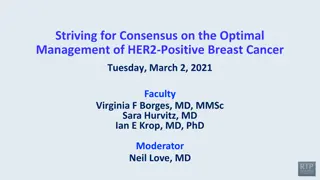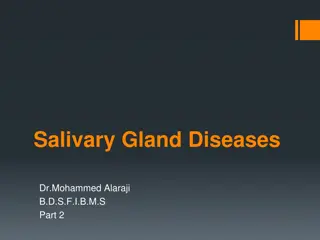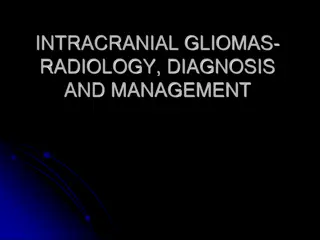HER2 Tyrosine Kinase Inhibitor Zongertinib Phase Ia/b Trial in Solid Tumors
Study on Zongertinib, a HER2 tyrosine kinase inhibitor, in patients with HER2 aberration-positive solid tumors. The trial involves multiple centers worldwide and aims to evaluate the efficacy of Zongertinib in treating various cancers harboring HER2 mutations. Financial disclosures of lead investigator John Heymach are also provided, showcasing his involvement in advisory boards, research grants, and employment affiliations.
Download Presentation

Please find below an Image/Link to download the presentation.
The content on the website is provided AS IS for your information and personal use only. It may not be sold, licensed, or shared on other websites without obtaining consent from the author.If you encounter any issues during the download, it is possible that the publisher has removed the file from their server.
You are allowed to download the files provided on this website for personal or commercial use, subject to the condition that they are used lawfully. All files are the property of their respective owners.
The content on the website is provided AS IS for your information and personal use only. It may not be sold, licensed, or shared on other websites without obtaining consent from the author.
E N D
Presentation Transcript
Beamion LUNG-1: Phase Ia/b Trial of HER2 Tyrosine Kinase Inhibitor Zongertinib (BI 1810631) in Patients with HER2 Aberration-Positive Solid Tumors John Heymach,1 Noboru Yamamoto,2 Frans Opdam,3 Minal Barve,4 Hai-Yan Tu,5 Yi-Long Wu,5 Lukas Schroeter,6 Behbood Sadrolhefazi,7 Josep Serra,8 Kiyotaka Yoh,9 David Berz10 1Department of Thoracic/Head and Neck Medical Oncology, Division of Cancer Medicine, MD Anderson Cancer Center, University of Texas, Houston, TX, USA; 2Department of Thoracic Oncology, National Cancer Center Hospital, Tokyo, Japan; 3Department of Clinical Pharmacology, The Netherlands Cancer Institute, Amsterdam, The Netherlands; 4Mary Crowley Cancer Research, Dallas, TX, USA; 5Guangdong Lung Cancer Institute, Guangdong Provincial People s Hospital (Guangdong Academy of Medical Sciences), Southern Medical University, Guangzhou, China; 6Boehringer Ingelheim Pharma GmbH & Co. KG, Biberach an der Riss, Germany; 7Boehringer Ingelheim Pharmaceuticals, Inc., Ridgefield, CT, USA; 8Boehringer Ingelheim Espa a S.A., Barcelona, Spain; 9Department of Thoracic Oncology, National Cancer Center Hospital East, Kashiwa, Japan; 10Valkyrie Clinical Trials, Los Angeles, CA, USA 1.
Financial disclosures John Heymach reports Advisory board: Genentech, Mirati Therapeutics, Eli Lilly & Co, Janssen Pharmaceuticals, Boehringer Ingelheim, Regeneron, Takeda Pharmaceuticals, BerGenBio, Jazz Pharmaceuticals, Curio Science, Novartis, AstraZeneca, BioAlta, Sanofi, Spectrum Pharmaceuticals, GlaxoSmithKline, EMD Serono, BluePrint Medicine, Chugai Pharmaceutical Full/part-time employment: MD Anderson Cancer Center Licensing fees and royalties: Spectrum Pharmaceuticals Research grant: AstraZeneca, Boehringer Ingelheim, Spectrum Pharmaceuticals, Mirati Therapeutics, Bristol Myers Squibb and Takeda Pharmaceuticals John Heymach, MD Anderson Cancer Center, University of Texas, Houston, TX, USA 2.
HER2 mutations occur in many solid tumors HER2 mutation frequencies in solid tumors1 Distribution of HER2 mutations2,3* 11% Other Esophageal (4 8%) Head and neck (2%) Exon21 <1% Exon20 48% Y772dupYVMA 33.9% Exon19 3% Lung (2 4%) Skin (2 7%) Exon18 2% Transmembrane 10% Extra-cellular 25% Pancreatic (1 2%) Breast (3 4%) G776delinsVC 5.7% S310F 5.1% I655V 4.5% P122L 2.3% A1057V 1.7% A1232fs 1.7% Bladder (12 13%) Colorectal (5 6%) Exons 1 2 3 4 5 6 7 8 9 10 11 12 13 14 15 16 17 18 19 20 21 22 31 Cervical (3 6%) Prostate (1%) G222C 1.1% E1021Q 2.3% G778dupGSP 3.4% HER2 mutations occur across the gene, but the TKD is a hotspot, with ~50% of all mutations2,3 Of all HER2 TKD mutations, 90% are ex20ins mutations1 HER2 Ex20ins mutations have traditionally been resistant to TKIs1 *Figure adapted from Wilding B, et al. Nature Cancer 2022;554:821 36 Ex20ins, exon 20 insertion; HER2, human epidermal growth factor receptor 2; TKD, tyrosine kinase domain; TKI, tyrosine kinase inhibitor 1. Baraibar I, et al. Crit Rev Oncol Hematol 2020;148:102906; 2. Hyman DM, et al. Nature 2018;554:189 94; John Heymach, MD Anderson Cancer Center, University of Texas, Houston, TX, USA 3. 3. Robichaux JP, et al. Cancer Cell 2019;36:444 57
Mechanism of action of zongertinib Selectivity for HER2 over EGFR1,* Zongertinib Previous ErbB TKIs EGFRWT HER2YVMA,C805S HER2YVMA HER2 TKD mutations, including ex20ins EGFRWT Tumor cell HER2 TKD mutations, including ex20ins HER2YVMA,C805S HER2YVMA Wild-type HER2 Mutant HER2 Wild-type EGFR Wild-type EGFR Wild-type HER2 Mutant HER2 EGFRWT HER2YVMA,C805S HER2YVMA EGFRWT Limited activity against ex20ins Active against ex20ins HER2YVMA,C805S HER2YVMA Wild-type EGFR blocked Wild-type EGFR sparing 1 10 100 1000 Fewer adverse events expected More adverse events expected IC50 (nM) Common adverse events caused by blocking EGFR Poziotinib BI-4142 BI-1622 Pyrotinib Gastrointestinal Skin *Figure adapted from Wilding B, et al. Nature Cancer 2022;554:821 36 and showing the median with upper/lower whiskers to largest/smallest value no further than 1.5 interquartile range. EGFR, epidermal growth factor receptor; ex20ins; exon 20 insertion; HER2, human epidermal growth factor receptor 2; IC50, half-maximum inhibitory concentration; TKD, tyrosine kinase domain; TKI, tyrosine kinase inhibitor. 1. Wilding B, et al. Nature Cancer 2022;554:821 36 John Heymach, MD Anderson Cancer Center, University of Texas, Houston, TX, USA 4.
Beamion LUNG-1 (NCT04886804): trial design/endpoints Phase Ib: dose expansion (in patients with HER2 mutation-positive NSCLC) Phase Ia: dose escalation (in patients with advanced solid tumors with HER2aberrations*) Cohort 1 Cohort 1 n=~36 n=~30 150 mg 360 mg Interim futility analysis 300 mg Cohort 2 Cohort 5 Cohort 2 Cohort 5 100 mg 240 mg 60 mg 180 mg 30 mg 120 mg Cohort 3 (experimental) Cohort 4 (experimental) 15 mg 60 mg One oral dose, BID, 3-week cycles One oral dose, QD, 3-week cycles Ongoing Pre-treated NSCLC with a HER2 TKD mutation Cohort 1: Phase Ia primary endpoints Phase Ib primary endpoints Cohort 2: Treatment-na ve NSCLC with a HER2 TKD mutation OR, according to RECIST v1.1 MTD and DLTs (MTD evaluation period) NSCLC with a non-TKD HER2 mutation or HER2 TKD mutation-positive squamous NSCLC, pretreated Key inclusion criteria Key inclusion criteria Cohort 3: HER2 aberration: overexpression, amplification, somatic mutation, or gene rearrangement involving HER2 or NRG1 Patients with HER2 mutation-positive NSCLC NSCLC with active brain metastases with a HER2 TKD mutation Cohort 4: Received 1 line of platinum-based combination chemotherapy (Cohorts 1, 3, 5) NSCLC with a HER2 TKD mutation and prior treatment with HER2 directed antibody drug conjugates Exhausted or not suitable for existing standard treatment options In Cohort 1 of Phase Ib, patients have been randomized to receive either 240 mg or 120 mg QD in 3-week cycles until one dose is selected at an interim analysis Cohort 5: *Overexpression, amplification, somatic mutation, or gene rearrangement involving HER2 or NRG1; Excluding patients pre-treated with antibody drug conjugates. BID, twice daily; DLTs, dose-limiting toxicities; HER2, human epidermal growth factor receptor 2; MTD, maximum tolerated dose; NRG1, neuregulin 1; NSCLC, non-small cell lung cancer; OR, objective response; QD, once a day; RECIST v1.1, Response Evaluation Criteria in Solid Tumors version 1.1; TKD, tyrosine kinase domain John Heymach, MD Anderson Cancer Center, University of Texas, Houston, TX, USA 5.
Phase Ia baseline characteristics Characteristic Phase Ia (N=61) Characteristic Phase Ia (N=61) Diagnosis, n (%) Median age, years (range) 60 (31 79) Male sex, n (%) 33 (54.1) NSCLC 32 (52.5) Race, n (%)* Lung cancer, unspecified 4 (6.6) Asian 35 (57.4) Colorectal cancer 4 (6.6) White 22 (36.1) Endometrial cancer 3 (4.9) ECOG PS, n (%) Other tumors 12 (19.7) HER2 aberration, n/N tested (%) 0 22 (36.1) 1 38 (62.3) Mutation 29/54 (53.7) Previous lines of therapy, n (%) Amplification 5/6 (83.3) Overexpression 2 23 (37.7) 13/17 (76.5) >2 32 (52.5) Rearrangement involving HER2 or NRG1 11/54 (20.4) Data cut-off: September 29, 2023 *Four patient (6.6%) had missing data; One patient (1.6%) had missing data; Six patients (9.8%) had missing data; Seven patients (11.5%) had missing data; 1+, 2+, or 3+ on immunohistochemistry. ECOG PS, Eastern Cooperative Oncology Group performance status; HER2, human epidermal growth factor receptor 2; NRG1, neuregulin 1; NSCLC, non-small cell lung cancer John Heymach, MD Anderson Cancer Center, University of Texas, Houston, TX, USA 6.
Phase Ia dose escalation and safety BID (n=17) QD (n=44) Total (N=61) 2 DLTs during MTD evaluation period (i.e., Cycle 1): 240 mg QD, grade 3 diarrhea 360 mg QD, grade 3 platelet count decreased 5patients with DLTs during the on-treatment period: 2 diarrhea (150 mg BID grade 2 and 240 mg QD grade 3) 1 edema (60 mg BID grade 2) 1 ALT, AST and bilirubin increased (180 mg QD grades 3, 2 and 2) 1 platelet count decreased (360 mg QD grade 3) 3 TRAEs led to discontinuation: 1 hypoxic ischemic encephalopathy (60 mg QD grade 4) 1 ALT increased (180 mg QD grade 3) 1 lung neoplasm malignant (240 mg QD grade 3) Phase Ia TRAEs (%*) Any Grade Any Grade Any Grade 3 3 3 Any TRAE 76.5 5.9 70.5 11.4 72.1 9.8 Diarrhea 47.1 31.8 2.3 36.1 1.6 ALT increased 5.9 5.9 13.6 4.5 11.5 4.9 AST increased 5.9 13.6 2.3 11.5 1.6 Rash 11.8 11.4 11.5 Paronychia 5.9 9.1 8.2 Anemia 11.8 4.5 6.6 MTD not reached with either BID or QD schedule Dry skin 11.8 4.5 6.6 Doses taken into optimization: 240 mg and 120 mg QD Data cut-off: September 29, 2023 *Includes TRAEs in 6% of total patients; Combined term, includes rash, rash maculo-papular, dermatitis acneiform. ALT, alanine aminotransferase; AST, aspartate aminotransferase; BID, twice daily; DLT, dose-limiting toxicity; MTD, maximum tolerated dose; QD, once a day; TRAEs, treatment-related adverse events John Heymach, MD Anderson Cancer Center, University of Texas, Houston, TX, USA 7.
Antitumor response in Phase Ia The overall median (range) duration of treatment with zongertinib was 4.8 (0.03 18.7) months 8 (1 28) Median number of cycles (range) Overall (N=53)* ORR: 49.1% DCR: 90.6% NSCLC (n=36)* ORR: 58.3% DCR: 97.2% 100 80 Best change from baseline 57.4% 60 in target lesions (%)* 40 Patients still on treatment at data cut-off Patients 20 0 -20 PR Median DoR (95% CI) : 12.7 months (4.2 12.7) -40 SD PD -60 Ongoing NSCLC Other -80 -100 500 0 50 100 150 200 250 300 350 400 450 Time since treatment start (days) Data cut-off: September 29, 2023 *Patients with 1 post-baseline tumor assessment or discontinued before first assessment for any reason; Kaplan-Meier estimate. CI, confidence interval; DCR, disease control rate; DoR, duration of response; NSCLC, non-small cell lung cancer; ORR, objective response rate; PD, progressive disease; PR, partial response; SD, stable disease John Heymach, MD Anderson Cancer Center, University of Texas, Houston, TX, USA 8.
Phase Ib baseline characteristics Cohort 1: Pre-treated NSCLC with a HER2 TKD mutation Phase Ib baseline characteristics N=42 Median age, years (range) Male sex, n (%) Race, n (%)* Asian White ECOG PS, n (%) 0 1 Previous lines of therapy, n (%) 2 >2 62 (34 80) 20 (47.6) 24 (57.1) 13 (31.0) 12 (28.6) 26 (61.9) 26 (61.9) 12 (28.6) Data cut-off: July 31, 2023 *Data missing for 5 (11.9%) patients; Data missing for 4 (9.5%) patients. ECOG PS, Eastern Cooperative Oncology Group performance status; HER2, human epidermal growth factor receptor 2; NSCLC, non-small cell lung cancer; TKD, tyrosine kinase domain John Heymach, MD Anderson Cancer Center, University of Texas, Houston, TX, USA 9.
Phase Ib preliminary safety 120 mg QD (n=19) 240 mg QD (n=23) Total (N=42) 0discontinuations due to adverse events 2 patients had DLTs in MTD evaluation period: 240 mg QD, grade 3 febrile neutropenia 240 mg QD, grade 4 immune thrombocytopenia 1 patient had DLTs during the on-treatment period: 240 mg QD, grade 3 ALT and AST increased, and grade 4 neutrophil count decreased 1 patient with TRAEs that led to dose reduction: Grade 3 febrile neutropenia and grade 3 neutrophil count decreased Any Grade Grade 3 13.0 4.3 4.3 Grade 3 9.5 2.4 2.4 Any Any Phase Ib TRAEs (%*) Any TRAE Diarrhea Rash AST increased Decreased appetite Dysgeusia ALT increased Anemia Bilirubin conjugate increased 10.5 Platelet count decreased 3 5.3 73.7 26.3 15.8 10.5 15.8 5.3 5.3 5.3 60.9 30.4 26.1 8.7 4.3 13.0 8.7 8.7 4.3 4.3 66.7 28.6 21.4 9.5 9.5 9.5 7.1 7.1 7.1 7.1 10.5 Data cut-off: July 31, 2023 * 5% of total patients; Combined term, includes rash, rash maculo-papular, rash macular and dermatitis acneiform. ALT, alanine aminotransferase; AST, aspartate aminotransferase; DLT, dose-limiting toxicity; MTD, maximum tolerated dose; John Heymach, MD Anderson Cancer Center, University of Texas, Houston, TX, USA 10. QD, once a day; TRAEs, treatment-related adverse events
Antitumor activity in Phase Ib 100 Overall (N=23)* ORR: 73.9% DCR: 91.3% Best change from baseline 80 in target lesions (%) 60 All responders are ongoing 40 20 0 -20 -40 -60 -80 -100 Patients included in the efficacy analysis had completed 2 5 cycles of treatment at data cut-off Median best percentage change from baseline in target lesions: -41.2% The first pre-planned interim futility analysis in Cohort 1 was passed and the trial is ongoing Data cut-off: July 31, 2023 *Patients that started treatment at least 7 weeks prior to the snapshot date; Patients that started treatment at least 7 weeks prior to the snapshot date with baseline and post-baseline tumor assessments. John Heymach, MD Anderson Cancer Center, University of Texas, Houston, TX, USA 11. DCR, disease control rate; ORR, objective response rate
Conclusions In Phase Ia, the MTD of zongertinib was not reached Doses taken into dose optimization are 240 mg and 120 mg QD Zongertinib was well tolerated with low rates of EGFR-mediated adverse events and no discontinuations in Phase Ib The planned futility analysis was passed, and the trial is continuing, with recruitment into all cohorts ongoing Currently, patient numbers in Phase Ib are small and investigator-assessed tumor responses are reported without the requirement of confirmation by a second scan. Nevertheless, initial efficacy results in patients with HER2 TKD mutation-positive NSCLC are encouraging EGFR, epidermal growth factor receptor; HER2, human epidermal growth factor receptor 2; MTD, maximum tolerated dose; NSCLC, non-small cell lung cancer; QD, once a day; TKD, tyrosine kinase domain John Heymach, MD Anderson Cancer Center, University of Texas, Houston, TX, USA 12.
Acknowledgments The authors thank the patients and their families, as well as the investigators and staff at the participating sites This study was funded by Boehringer Ingelheim The authors were fully responsible for all content and editorial decisions, were involved at all stages of development, and have approved the final version of this presentation The authors did not receive payment related to the development of this presentation Medical writing support for the development of this presentation, under the direction of the authors, was provided by Frans Everson PhD, of Ashfield MedComms, an Inizio Company, and funded by Boehringer Ingelheim John Heymach, MD Anderson Cancer Center, University of Texas, Houston, TX, USA 13.
